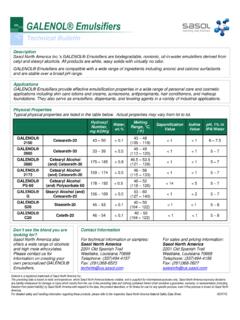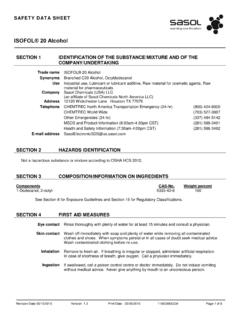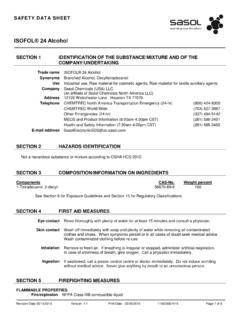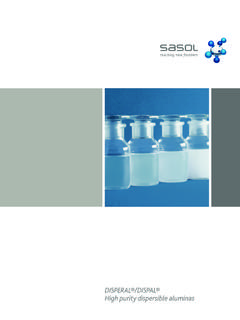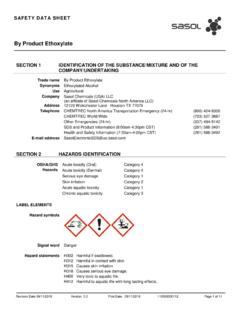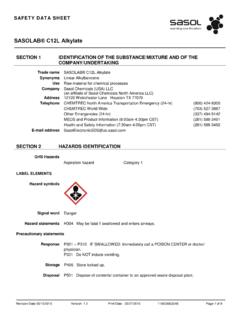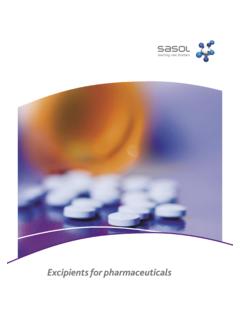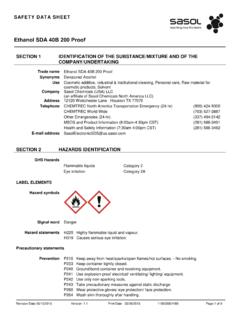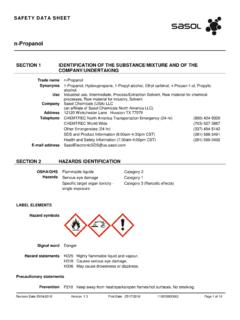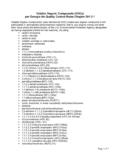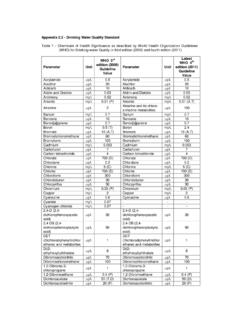Transcription of 1,4-Dioxane – A Current Topic for Household …
1 1,4-Dioxane A Current Topic for Household detergent and personal care FormulatorsL. Matheson and G. Russell - SASOL MacArthur and W. B. Sheats - Chemithon100th AOCS Annual Meeting, May 6, 20091,4- dioxane : What Are The Issues?Recent reports suggest that 1,4-Dioxane has been detected at measurable levels (1 to 100ppm) in some personal care ,4- dioxane is recognized as a toxic substance that should be controlled. The source of 1,4-Dioxane has been inaccurately reported. The reality is: 1,4-Dioxane is not a significant by-product of the base-catalyzed ethoxylation of fatty alcohols. 1,4-Dioxane is a controllable by-product of the highly acidic sulfation process to make purchased from is 1,4-Dioxane ?1,4-DioxaneNot to Be Confused with DioxinDioxin1,4- dioxane is not the same as focus of this presentation is on how and where 1,4- dioxane is created and what can be done to control its , it should be noted that thorough risk assessments of 1,4-Dioxane exposure from cleaning products have been examples can be found at: (Human and Environmental Risk Assessment) is a voluntary industry program to carry out risk assessements on Household cleaning product Ethoxylates Version (2007, May)Alcohol Ethoxysulphates Human Health Risk Assessment Draft.
2 (2003, January)Risk from 1,4-Dioxane Exposure in Household and personal care ProductsWhere Does 1,4-Dioxane Come From?Recent publications suggest 1,4-Dioxane is formed through ethoxylation of fatty , in-house evaluation of alcohol ethoxylates produced by Sasol North America shows <5ppm of 1,4-Dioxane in the ethoxylates used in Household and personal care products. Photo purchased from Does 1,4-Dioxane Come From?RO H + M+OH-RO- + M+ + H2 OFeedstock CatalystEORO CH2CH2O-EORO +RO (CH2CH2O)nHEthoxylate1,4- dioxane is not easily formed under conditions of alkaline catalyzed ethoxylation of fatty 1,4-Dioxane is produced during the sulfation of ethoxylated alcohols to make AES. The thin film sulfation reaction with SO3 occurs under highly acidic has been recognized for some time, and control methods are practiced in the that active levels of any one ingredient in personal care products are about 10%, then the 1,4- dioxane in the final product would be diluted by a factor of 10 from that of the starting Does 1,4-Dioxane Come From?
3 SO3 Sulfation of Alcohol Ethoxylates (AE)R-(EO)n -OH + SO3 R-(EO)n -OSO3 HReaction occurs under strongly acidic of the AES acid should occur promptly after sulfation to minimize decomposition and to reduce by-product H + NaOHROSO3 NaFormation of 1,4-Dioxane by Excess SO31,4- dioxane can be formed from ethoxymers with >1 mole of EO when excess SO3 is Influencing the Level of 1,4-Dioxane During the Sulfation of AE to Make AESP rocess and Equipment FactorsSO3 : AE feed mole ratioReactor loading%SO3 concentration in airResidence time of AES acid prior to neutralizationDe-aeration and stripping of AES pasteFeedstock Compositional Factors Average degree of ethoxylationPEG and moisture contentEO adduct distribution1,4- dioxane Study by Chemithon and SasolObjective: Sulfate an alcohol ethoxylate and generate response surfaces showing dependence of 1,4-Dioxane on process conditions for making Design:Three Factorial Design - Central CompositeSO3 : AE feed mole ratio%SO3 concentration in airReactor loading (kg/hr-cm of wetted reactor surface)Response Measurements 1,4-Dioxane (ppm in 100% active product)Klett Color (5% active basis, 40mm path)Free Oil (wt% in 100% active product)Sodium Sulfate (wt% in 100% active product)AE Feedstock for Experimental Design StudyFeedstock Analysis:C1412-3 Ethoxylate KOH catalyzed linear, primary C12 and C14 alcohol ethoxylated to approximately 3 molesAve Moles EO: MW: Free Alcohol: PEG: 1,4-Dioxane : Moisture: 2601,4- dioxane vs.
4 Loading & Mole Ratio at 3% SO3------Then------Constant Factor: 3% SO3 in airLoadingLoadingMole RatioMole Ratio1,4-Dioxane1,4-DioxaneMole Ratio&ReactorLoading1,4-Dioxane1,4-Dioxa ne vs. Loading & Mole Ratio at 4% SO3 Mole RatioMole RatioLoadingLoading1,4-Dioxane1,4-Dioxan eConstant Factor: 4% SO3 in airReactor LoadingMole Ratio1,4- dioxane ------Then------1,4-Diox ane vs. SO3 Concentration & Mole RatioSO3 ConcSO3 ConcMole RatioMole Ratio1,4-Dioxane1,4-DioxaneConstant Factor: Reactor Loading------Then------Mole Ratio&SO3 Concentration1,4-Dioxane1,4- dioxane vs. SO3 Concentration & Reactor LoadingLoadingLoadingSO3 ConcSO3 Conc1,4-Dioxane1,4-DioxaneConstant Factor: Mole Ratio(Slight excess of AE)SO3 ConcentrationReactorLoading------Then--- --- 1,4-Dioxane ------Then------Color vs. SO3 Concentration and Mole RatioLow color is a very important quality parameter for AES for personal care formulations. Mole RatioMole RatioSO3 ConcSO3 ConcKlettColorKlettColorConstant Factor: Reactor LoadingSO3 ConcentrationKlettColorColor vs.
5 SO3 Concentration and Reactor Mole RatioLoadingLoadingSO3 ConcSO3 Conc1,4-Dioxane1,4-DioxaneLoadingLoading SO3 ConcSO3 ConcKlettColorKlettColorConditions which yield low color ( low SO3 concentration), will generally yield low levels of 1,4- ,4- dioxane &Klett ColorThenFree Oil vs. SO3 Concentration and Mole RatioConditions which give lower 1,4-Dioxane generally yield high free oil RatioMole RatioSO3 ConcSO3 ConcFree OilFree OilConstant Factor: Reactor LoadingMole Ratio------Then------Free OilHow to Minimize 1,4-Dioxane in AES1. Proper Conditions for Thin Film SO3 SulfationSO3 to AE mole ratio of or lowerSO3 concentration in air at 3%Reactor loading at ~1 kg/hr - cm2. Properly Designed Thin Film Sulfation Equipment1,4- dioxane Reduction by Stripping AES PasteReduction of 1,4-Dioxane content in neutral 70% AES paste can be accomplished by reduction factor (Inlet 1,4-Dioxane /Outlet 1,4-Dioxane ) in a single stripping stage depends on the weight ratio of stripping steam to AES paste ratios from 2 to 10 can be achieved of 70 wt% active AES paste occurs simultaneously upon Stripping System for 1,4-Dioxane RemovalSteamCondSteam1,4-DioxaneDestruct ion Product AESAES PasteStripper1,4- dioxane Removal in Stripper72% Active AES with 100ppm Inlet Stripper Outlet 1,4-Dioxane (ppm wt 100% Act.)
6 Basis)How to Minimize 1,4-Dioxane in AES1. Proper Conditions for Thin Film SO3 SulfationSO3 to AE mole ratio of or lowerSO3 concentration in air at 3%Reactor loading at ~1 kg/hr - cm2. Properly Designed Thin Film Sulfation EquipmentSulfation reactor and subsequent neutralizationDe-aeration and stripping of neutralized 70% active AES paste3. Appropriate Choice of AE FeedstockLaboratory Studies on 1,4-Dioxane FormationSulfation with excess SO3 Ethoxylate Feedstock CharacteristicsDegree of EthoxylationContent of High Mole PEG By-ProductContent of High Mole EO AdductsThe Effect of SO3 / AE Mole Ratio Ratio of SO3/ETO1,4- dioxane (ppm) 1,4-Dioxane vs. EO Adduct Length in AESppm 1,4-Dioxane (100% active basis)00408212812185817822093128505001,0 001,5002,0002,500012345678C12 EO Adduct Chain Length`Ethoxylate comparisons are on equimolar basis, sulfated at mole of 1,4-Dioxane by Excess SO3 Excess SO3 finds few unreacted hydroxyl groups and attacks ether oxygens EO adducts have more sites to EO2 EO3 EO1214GC (70:30) Alcohol EO Adduct DistributionsEO Mole AdductsWeight %1214GC-1 10 Wt% 5 EO1214GC-2 25 Wt% 5 EO1214GC-3 39 Wt% 5EO 0510152025300246810121416 BRENREEO Adduct Distributions for 1214GC-2 Mole Ethoxylates, NRE vs.
7 BREEO Mole AdductsWeight %BRE 25 Wt% 5 EONRE 11 Wt% 5 EOEffect of By-Product PEG in AEHOOOOOOOOOOOOOOOHPEG comes from residual water present during PEG by-product in 1412-3 ethoxylate Less than weight % PEG in AE Ave. MW of 750 for PEG (17 EO units) compared to 435 for alcohol ethoxylate (3 EO units)H2 O + EO HO CH2 CH2 O H+ more EOEthylene GlycolEffect of Moisture in Sulfation FeedH2 O + SO3 (gas) H2 SO4 (liquid)H2 O combines with SO3 and forms H2 SO4H2 SO4 condenses as liquid droplets and forms localized excess of sulfating and heat of reaction can lead to increased formation of 1, to Minimize 1,4-Dioxane in AES1. Proper Conditions for Thin Film SO3 SulfationMole ratio of or lowerSO3 concentration in air at 3%Reactor Loading at ~1 kg/hr - cm2. Properly Designed Thin Film Sulfation EquipmentSulfation reactor and subsequent neutralizationStripping of neutralized 70% active AES paste3.
8 Appropriate choice of AE feedstockMinimize high mole EO adductsLow PEG and low moisture levels in AEConclusionsThe main source of the 1,4-Dioxane reported in Household and personal care products is from the sulfation of AE to produce alcohol ether sulfates (AES). Our data shows only 5ppm or less 1,4-Dioxane can be attributed to the original alcohol ethoxylate use of proper sulfation equipment, optimum process conditions, and good quality AE feed should produce AES containing less than 100ppm of 1,4-Dioxane on 100% active basis. Stripping of the 70% AES paste can reduce the 1,4-Dioxane levels even further.
